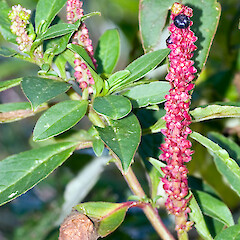Phytolacca octandra
Common name
inkweed
Family
Phytolaccaceae
Flora category
Vascular – Exotic
Structural class
Trees & Shrubs - Dicotyledons
NVS code
The National Vegetation Survey (NVS) Databank is a physical archive and electronic databank containing records of over 94,000 vegetation survey plots - including data from over 19,000 permanent plots. NVS maintains a standard set of species code abbreviations that correspond to standard scientific plant names from the Ngä Tipu o Aotearoa - New Zealand Plants database.
PHYOCT
Conservation status
Not applicable
Habitat
Terrestrial.
Wetland plant indicator status rating
Information derived from the revised national wetland plant list prepared to assist councils in delineating and monitoring wetlands (Clarkson et al., 2021 Manaaki Whenua – Landcare Research Contract Report LC3975 for Hawke’s Bay Regional Council). The national plant list categorises plants by the extent to which they are found in wetlands and not ‘drylands’. The indicator status ratings are OBL (obligate wetland), FACW (facultative wetland), FAC (facultative), FACU (facultative upland), and UPL (obligate upland). If you have suggestions for the Wetland Indicator Status Rating, please contact: [Enable JavaScript to view protected content]
FACU: Facultative Upland
Occasionally is a hydrophyte but usually occurs in uplands (non-wetlands).
Detailed description
Glabrous, spreading or mainly erect subshrub to approx. 2m tall, with numerous white raphides on stems and lower surface of leaves. Stems softly woody towards base, often reddish. Petioles to 2.5cm long, moderately thick, often reddish. Lamina 4~15 x 1.5~5cm, elliptic or elliptic-ovate; base cuneate to attenuate; apex acute or mucronate. Racmes erect to approx. 7cm at flowering, to 11cm at fruiting; peduncles and very short pedicels mostly granular, becoming crimson at fruiting. Hermaphrodite flowers dense. Bracts 3~4mm long, linear-lanceolate to subulate; bracteoles much smaller. Perianth 5~7mm diam.; tepals accrescent, 2~3mm long, broad-ovate, imbricate, whitish or pale greenish at first, becoming pink to crimson at fruiting. Stamens 8, slightly < perianth; anthers white. Ovary 8-carpellate, green with numerous white raphides. Fruit about 8mm diam. when fresh, depressed globose, with 8 very shining black, very succulent with dark red juice. Seed 2~2.5mm diam., subglobose, glossy black. (-Webb et. al., 1988)
Similar taxa
The plant is a perennial soft-wooded shrub forming round bushes 1.2 - 1.8 metres tall (Hilgendorf 1926). The branches are brittle and the leaves are 8 - 10 cm long (Hilgendorf 1926). The flowers are small and green and inconspicuous (Hilgendorf 1926). The flowers are arranged on upright tapering spikes 12 - 15 cm long (Hilgendorf 1926). The berries are deep purple in colour (almost black) (Hilgendorf 1926). The berries are filled with a rich purple juice (Hilgendorf 1926).
Flowering
November, December, January, February, March, April, May, June, July, August
Flower colours
Green, White
Life cycle
Perennial. The seed is eaten by birds (Hilgendorf 1926; Department of Conservation 1996) and doubtless distributed by them. Silver eyes, pheasants and turkeys are fond of the fruit and cattle and sheep eat the berries (Hilgendorf 1926).
Year naturalised
1867
Origin
trop C&S America
Reason for introduction
Ornamental
Poisonous plant:
All parts of this plant are poisonous especially the spikes on the black berries.









